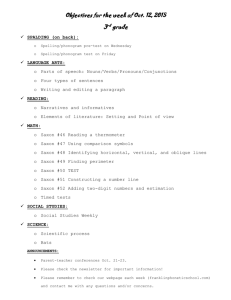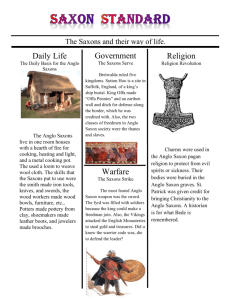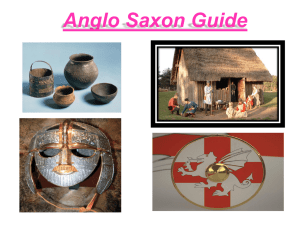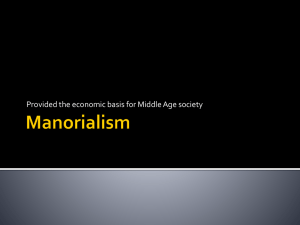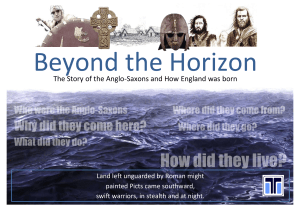The Anglo Saxons - Takeley Local History Society
advertisement
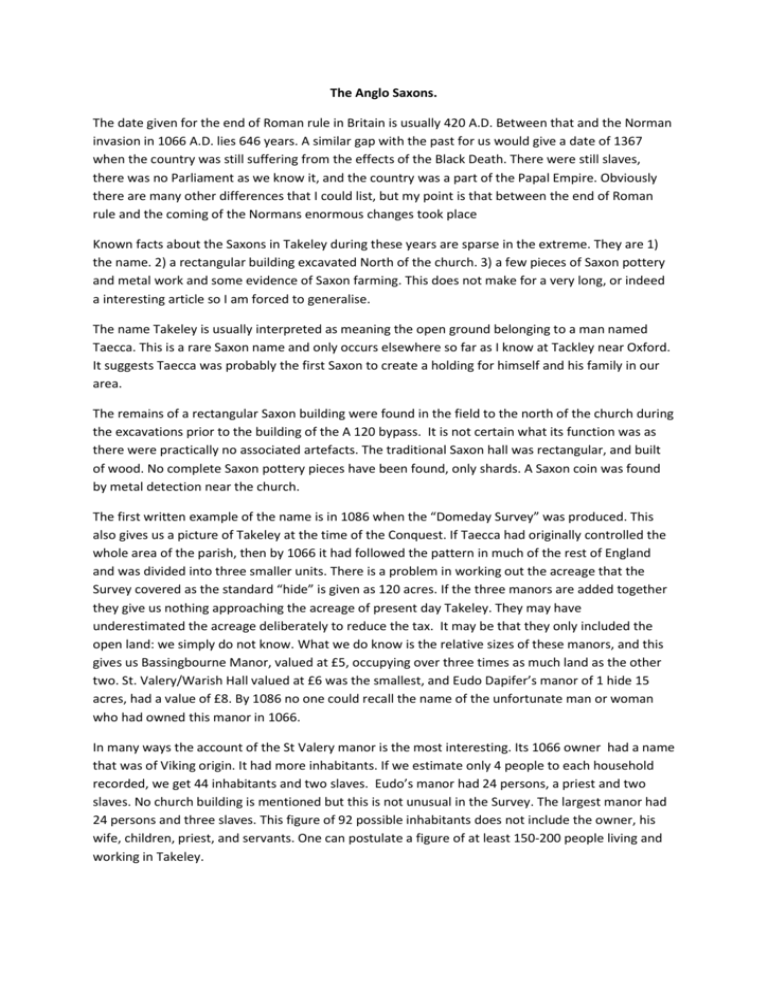
The Anglo Saxons. The date given for the end of Roman rule in Britain is usually 420 A.D. Between that and the Norman invasion in 1066 A.D. lies 646 years. A similar gap with the past for us would give a date of 1367 when the country was still suffering from the effects of the Black Death. There were still slaves, there was no Parliament as we know it, and the country was a part of the Papal Empire. Obviously there are many other differences that I could list, but my point is that between the end of Roman rule and the coming of the Normans enormous changes took place Known facts about the Saxons in Takeley during these years are sparse in the extreme. They are 1) the name. 2) a rectangular building excavated North of the church. 3) a few pieces of Saxon pottery and metal work and some evidence of Saxon farming. This does not make for a very long, or indeed a interesting article so I am forced to generalise. The name Takeley is usually interpreted as meaning the open ground belonging to a man named Taecca. This is a rare Saxon name and only occurs elsewhere so far as I know at Tackley near Oxford. It suggests Taecca was probably the first Saxon to create a holding for himself and his family in our area. The remains of a rectangular Saxon building were found in the field to the north of the church during the excavations prior to the building of the A 120 bypass. It is not certain what its function was as there were practically no associated artefacts. The traditional Saxon hall was rectangular, and built of wood. No complete Saxon pottery pieces have been found, only shards. A Saxon coin was found by metal detection near the church. The first written example of the name is in 1086 when the “Domeday Survey” was produced. This also gives us a picture of Takeley at the time of the Conquest. If Taecca had originally controlled the whole area of the parish, then by 1066 it had followed the pattern in much of the rest of England and was divided into three smaller units. There is a problem in working out the acreage that the Survey covered as the standard “hide” is given as 120 acres. If the three manors are added together they give us nothing approaching the acreage of present day Takeley. They may have underestimated the acreage deliberately to reduce the tax. It may be that they only included the open land: we simply do not know. What we do know is the relative sizes of these manors, and this gives us Bassingbourne Manor, valued at £5, occupying over three times as much land as the other two. St. Valery/Warish Hall valued at £6 was the smallest, and Eudo Dapifer’s manor of 1 hide 15 acres, had a value of £8. By 1086 no one could recall the name of the unfortunate man or woman who had owned this manor in 1066. In many ways the account of the St Valery manor is the most interesting. Its 1066 owner had a name that was of Viking origin. It had more inhabitants. If we estimate only 4 people to each household recorded, we get 44 inhabitants and two slaves. Eudo’s manor had 24 persons, a priest and two slaves. No church building is mentioned but this is not unusual in the Survey. The largest manor had 24 persons and three slaves. This figure of 92 possible inhabitants does not include the owner, his wife, children, priest, and servants. One can postulate a figure of at least 150-200 people living and working in Takeley. To us the existence of slaves has an unpleasant ring, but slavery or serfdom existed legally in ever decreasing numbers until the reign of Elizabeth I. Technically the Church did not approve of slavery, but it seems to have done nothing to foster its eradication. Domesday shows that Takeley was heavily wooded with a small population. The names Thorkill and Wulfmer occur in other local manors, but there is no means of knowing if they are the same men as the Takeley owners. St Valery and Eudo’s manor had equal amounts of woodland, with Bassingbourne having only a fifth of their total. They also had 30 actual pigs each to Bassingbourne’s 20 pigs. St Valery in 1066 was the only manor with a mill - a water mill based on the River Roding. I think it is still possible to see where the mill pond was situated. If one walks back along the river from the road, there is round area of water and marsh. Under the Normans they had to share their mill with the manor of Little Canfield. Great Canfield had its own water mill. The other interesting item in the St Valery list is the five beehives. For the rest of the livestock I am showing it as a list. This makes for an easier comparison. The woodland figure with pigs is said to represent the number of pigs the wood could sustain, and not the actual number of pigs. Cobs Sheep Cattle Goats Pigs Meadow Mill Wood St Valery 3 28 4 5 30 24 a. 1 1,000 [pigs]. Eudo 1 80 14 30 30 16 .a 0 1,000 [pigs]. Bassingbourne 2 16 12 0 20 20 a. 0 200 [pigs]. There is no mention of a church, but this was not uncommon in the Survey. Known Saxon churches such as Chickney are also not listed in the Survey. This shows that Takeley was still heavily wooded and had only a small population. A man named Thorkill held manors in Birchanger and Widdington as well as other places further away from Takeley. However it is not an unusual name and there is now no way of telling if this is the same Thorkill. The same applies to Wulfmer. This name is listed against many manors spread over the county If they held other manors then they would have travelled between them just as their Norman successors were to do. We are still left with major gaps—when did the Saxons arrive in Takeley; when were the manors formed, and many other unanswerable questions. I need to look at the history of the area as a whole to try to come to some conclusions. Since the Anglo Saxons came from Northern Europe by sea then the coast of East Anglia was one of the obvious places for them to land. This is confirmed by early examples of settlement along the coast and Thames estuary. It is a reasonable assumption that the people who settled in Essex came from Saxony—the East Saxons- hence the name Essex. Excavations in East Anglia- the area settled by the Angles- show that Anglo-Saxon men of apparently warrior status men had been born there as early 470 A.D. There are Essex cemeteries dating from the late 5th Century at Little Oakley, Springfield Lyons and Rayleigh, with Rayleigh containing as many as 150 bodies and there is a probable further unexcavated cemetery. These people were not warriors, but ordinary settlers and farmers with dateable grave goods. The grave of a rich young woman who is thought to have been a Christian was excavated at Trumpington and dates from c. 650 A.D. A site at Little Oakley is interesting because it shows that the Saxons did not occupy the Roman villa there, but used the material from the villa to create platforms for their wooden buildings. Stansted Airport excavations did not produce any evidence of buildings in the Saxon period, only of the agricultural activity that continued until the late 13th/early 14th century, when the site was finally abandoned. I will return to this in a later article. The historian Bede says that the local British kings had called in Anglo Saxon warriors to help to defend their territory during the confusion at the end of Roman rule. King Arthur, Hengist and Horsa, and Vorigern [real or imaginary heroes] are all figures from this confused period. Known Essex Kings Saebert, Saebbi and Sigberht were Christian converts and Essex graves from the mid 7th Century have both Christian and pagan elements and certainly reflect a wealthy society that was trading with the Continent. By 664-694, the “king” of the East Saxons, Saebbi was powerful enough to build a major construction at Mersea Island. Bede tells us that he was a deeply religious man. The church of St. Cedd at West Mersea predates him. So also do the marvellous remains at Sutton Hoo in Suffolk and Prittlewell in Essex. These contain both pagan and Christian elements. As early as 614 Essex had been included as part of the newly formed Diocese of London. This had a troubled history as Essex reverted periodically into paganism until the 8th century. A recent study has suggested that the area was more Christian than previously estimated, but I am uncertain as to the evidence on which this theory is based. The Danish incursions would certainly have disturbed the religious status of the county. We have no evidence as to when Takeley Saxons became Christian. I think the first place of worship was on the present site and was a field chapel or preaching cross maintained by the church at Hatfield Broad Oak. There may have been an existing pagan shrine and a grave yard here. This known Saxon church at Hatfield, and all the surrounding churches were originally dedicated to St. Mary. This could be a coincidence or could reflect their place of origin. Takeley church stands on a strip of land that was originally part of Dapifer’s manor. All this does not take us any closer to deciding when Taecca came to settle in Takeley. I think that he and his tribe followed the River Roding to its source at Mole Hill Green which gave them water and a more elevated position in the landscape, and that the Domesday manor of Dapifer was based here. My husband John does not agree with me about the route, and thinks that Stane Street is the most obvious way There is some support for his theory in that there is evidence of an early village just north of the church at the start of the of Church Lane or Dead man’s Lane. This however could be early medieval, not Saxon as it has not been excavated. Pottery pieces found were early medieval. The essential water supply was available as a house for the medieval vicar was built in what is now the extended church yard. I say “must” as a well was dug in 1910 in the church car park so water was present on the site. Either route would have brought the Saxons past the inhabitants of Lower Bambers Green. Why then did the local people allowed these intruders to pass by into their territory? Centuries of Roman rule had discouraged armed responses, and the Saxons were probably well armed and formidable. If they were already established in the east of Essex they also would not have been that unfamiliar to the Romano-British population. It is not very good historical thinking to have so many “theories”, “perhaps”, “possibly” in one’s article, but there is so little genuine evidence, that theorising is all that is left for any account of Takeley before 1066. Did men from Takeley join in the doomed defence of the causeway at Maldon by Earl Byrhtnoth against the Danes in 991, or join Harold Godwinson’s army at Stamford Bridge and then Hastings? If they were killed in these battles then the Takeley manors were untenanted after Hastings. Harold Godwinson, the short lived Anglo-Saxon King, had owned Hatfield Broad Oak and had considerable local support. One thing is certain: William of Normandy inherited a wealthy efficient state that paid its taxes. History is written by the winners, and it suited to the Norman conquerors to down play and despise Anglo-Saxon England. If information for Takeley is very sparse pre 1066, when I come to look at post 1066 the difficulty will be choosing what to leave out. This will have to wait until the next article. Nia Watkiss

